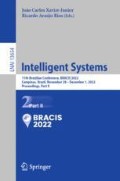Abstract
The next-generation sequencing technologies decreased the cost of protein sequence identification. However, the cost of determining protein functions is still high, due to the laboratory methods needed. With that, computational models have been used to annotate protein functions. In this work, we present and discuss a new approach for protein Molecular Function prediction based on Transformers embeddings. Our method surpassed state-of-the-art classifiers when it used only the amino acid sequence as input and when it employed amino acid sequence and homology search in \(F_{\max }\) and AuPRC metrics.
Access this chapter
Tax calculation will be finalised at checkout
Purchases are for personal use only
References
Abadi, M., et al.: TensorFlow: Large-Scale Machine Learning on Heterogeneous Systems (2015). https://www.tensorflow.org
Altschul, S.F., et al.: Gapped BLAST and PSI-BLAST: a new generation of protein database search programs. Nucleic Acids Res. 25(17), 3389–3402 (1997)
Ashburner, M., et al.: Gene ontology: tool for the unification of biology. Nat. Genet. 25(1), 25–29 (2000)
Bonetta, R., Valentino, G.: Machine learning techniques for protein function prediction. Proteins Struct. Fun. Bioinform. 88(3), 397–413 (2020)
Buchfink, B., Reuter, K., Drost, H.G.: Sensitive protein alignments at tree-of-life scale using DIAMOND. Nat. Methods 18(4), 366–368 (2021)
Cao, Y., Shen, Y.: TALE: transformer-based protein function annotation with joint sequence-label embedding. Bioinformatics 37(18), 2825–2833 (2021)
Dayhoff, M.O.: Atlas of Protein Sequence and Structure. National Biomedical Research Foundation (1972)
Devlin, J., Chang, M.W., Lee, K., Toutanova, K.: BERT: Pre-training of Deep Bidirectional Transformers for Language Understanding. arXiv:1810.04805, May 2019
Dobson, C.M.: Protein misfolding, evolution and disease. Trends Biochem. Sci. 24(9), 329–332 (1999)
Elnaggar, A., et al.: Towards Cracking the Language of Life’s Code Through Self-Supervised Deep Learning and High Performance Computing. arXiv:2007.06225 (2021)
Fodeh, S., Tiwari, A., Yu, H.: Exploiting Pubmed for protein molecular function prediction via NMF based multi-label classification. In: IEEE International Conference on Data Mining Workshops (ICDMW), pp. 446–451 (2017)
Gong, Q., Ning, W., Tian, W.: GoFDR: a sequence alignment based method for predicting protein functions. Methods 93, 3–14 (2016)
Kulmanov, M., Hoehndorf, R.: DeepGOPlus: improved protein function prediction from sequence. Bioinformatics 36(2), 422–429 (2019)
Kulmanov, M., Hoehndorf, R.: DeepGOZero: improving protein function prediction from sequence and zero-shot learning based on ontology axioms. bioRxiv, pp. 1–9 (2022)
Kulmanov, M., Khan, M.A., Hoehndorf, R.: DeepGO: predicting protein functions from sequence and interactions using a deep ontology-aware classifier. Bioinformatics 34(4), 660–668 (2018)
Le, N.Q.K., Ho, Q.T., Nguyen, T.T.D., Ou, Y.Y.: A Transformer architecture based on BERT and 2D convolutional neural network to identify DNA enhancers from sequence information. Brief. Bioinform. 22(5), bbab005 (2021)
Lee, J., et al.: BioBERT: a pre-trained biomedical language representation model for biomedical text mining. Bioinformatics 36(4), 1234–1240 (2020)
Maiya, A.S.: KTrain: A Low-Code Library for Augmented Machine Learning. arXiv:2004.10703 (2020)
Peng, J., Xue, H., Wei, Z., Tuncali, I., Hao, J., Shang, X.: Integrating multi-network topology for gene function prediction using deep neural networks. Brief. Bioinform. 22(2), 2096–2105 (2021)
Ranjan, A., Fernandez-Baca, D., Tripathi, S., Deepak, A.: An ensemble TF-IDAF based approach to protein function prediction via sequence segmentation. IEEE/ACM Trans. Comput. Biol. Bioinf. 14(8), 1–12 (2021)
UniProt: UniProt Database (2022). https://www.uniprot.org
Vaswani, A., et al.: Attention is all you need. In: Advances in Neural Information Processing Systems (NIPS), pp. 5998–6008 (2017)
Vu, T.T.D., Jung, J.: Protein function prediction with gene ontology: from traditional to deep learning models. Peer J. 9, e12019 (2021)
Wan, C., Jones, D.T.: Protein function prediction is improved by creating synthetic feature samples with generative adversarial networks. Nat. Mach. Intell. 2(9), 540–550 (2020)
Wang, S., Cho, H., Zhai, C., Berger, B., Peng, J.: Exploiting ontology graph for predicting sparsely annotated gene function. Bioinformatics 31(12), i357–i364 (2015)
Wolf, T., et al.: Huggingface’s transformers: state-of-the-art natural language processing. arXiv:1910.03771 (2019)
Zehetner, G.: OntoBlast function: from sequence similarities directly to potential functional annotations by ontology terms. Nucleic Acids Res. 31(13), 3799–3803 (2003)
Zhang, F., Song, H., Zeng, M., Li, Y., Kurgan, L., Li, M.: DeepFunc: a deep learning framework for accurate prediction of protein functions from protein sequences and interactions. Proteomics 19(12), 1900019 (2019)
Zhou, N., et al.: The CAFA challenge reports improved protein function prediction and new functional annotations for hundreds of genes through experimental screens. Genome Biol. 20(1), 244 (2019)
Acknowledgements
This research was supported by São Paulo Research Foundation (FAPESP) [grant numbers 2015/11937-9, 2017/12646-3, 2017/16246-0, 2017/12646-3 and 2019/20875-8], the National Council for Scientific and Technological Development (CNPq) [grant numbers 161015/2021-2, 304380/2018-0 and 309330/2018-1], and Coordination for the Improvement of Higher Education Personnel (CAPES).
Author information
Authors and Affiliations
Corresponding author
Editor information
Editors and Affiliations
Rights and permissions
Copyright information
© 2022 The Author(s), under exclusive license to Springer Nature Switzerland AG
About this paper
Cite this paper
de Oliveira, G.B., Pedrini, H., Dias, Z. (2022). Protein Molecular Function Annotation Based on Transformer Embeddings. In: Xavier-Junior, J.C., Rios, R.A. (eds) Intelligent Systems. BRACIS 2022. Lecture Notes in Computer Science(), vol 13654 . Springer, Cham. https://doi.org/10.1007/978-3-031-21689-3_16
Download citation
DOI: https://doi.org/10.1007/978-3-031-21689-3_16
Published:
Publisher Name: Springer, Cham
Print ISBN: 978-3-031-21688-6
Online ISBN: 978-3-031-21689-3
eBook Packages: Computer ScienceComputer Science (R0)

